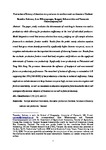Production Efficiency of Jasmine Rice Producers in Northern and North-eastern Thailand
| dc.contributor.author | Rahman, Sanzidur | |
| dc.contributor.author | Wiboonpongse, A | |
| dc.contributor.author | Sriboonchitta, S | |
| dc.contributor.author | Chaovanapoonphol, Y | |
| dc.date.accessioned | 2015-12-25T11:05:13Z | |
| dc.date.available | 2015-12-25T11:05:13Z | |
| dc.date.issued | 2009-06 | |
| dc.identifier.issn | 0021-857X | |
| dc.identifier.issn | 1477-9552 | |
| dc.identifier.uri | http://hdl.handle.net/10026.1/4020 | |
| dc.description.abstract |
The paper jointly evaluates the determinants of switching to Jasmine rice and its productivity while allowing for production inefficiency at the level of individual producers. Model diagnostics reveal that serious selection bias exists, justifying use of a sample selection framework in stochastic frontier models. Results from the probit variety selection equation reveal that gross return (mainly powered by significantly higher Jasmine rice price), access to irrigation and education are the important determinants of choosing Jasmine rice. Results from the stochastic production frontier reveal that land, irrigation and fertilisers are the significant determinants of Jasmine rice productivity. Significantly lower productivity in Phitsanulok and Tung Gula Rong Hai provinces demonstrate the influence of biophysical and environmental factors on productivity performance. The mean level of technical efficiency is estimated at 0.63 suggesting that 59% [(100-63)/ 63] of the productivity is lost due to technical inefficiency. Policy implications include measures to keep Jasmine rice price high, increase access to irrigation and fertiliser availability, as well as investment in education targeted to farm households which will synergistically increase adoption of Jasmine rice as well as farm productivity. © Journal compilation © 2009 The Agricultural Economics Society. | |
| dc.format.extent | 419-435 | |
| dc.language | en | |
| dc.language.iso | en | |
| dc.publisher | Wiley | |
| dc.subject | Jasmine rice producers | |
| dc.subject | sample selection framework | |
| dc.subject | stochastic production frontier | |
| dc.subject | technical efficiency | |
| dc.subject | Thailand | |
| dc.subject | O33 | |
| dc.subject | Q18 | |
| dc.subject | C21 | |
| dc.title | Production Efficiency of Jasmine Rice Producers in Northern and North-eastern Thailand | |
| dc.type | journal-article | |
| dc.type | Journal Article | |
| plymouth.author-url | https://www.webofscience.com/api/gateway?GWVersion=2&SrcApp=PARTNER_APP&SrcAuth=LinksAMR&KeyUT=WOS:000265508100010&DestLinkType=FullRecord&DestApp=ALL_WOS&UsrCustomerID=11bb513d99f797142bcfeffcc58ea008 | |
| plymouth.issue | 2 | |
| plymouth.volume | 60 | |
| plymouth.publication-status | Published | |
| plymouth.journal | Journal of Agricultural Economics | |
| dc.identifier.doi | 10.1111/j.1477-9552.2008.00198.x | |
| plymouth.organisational-group | /Plymouth | |
| plymouth.organisational-group | /Plymouth/Faculty of Arts, Humanities and Business | |
| plymouth.organisational-group | /Plymouth/Users by role | |
| dc.identifier.eissn | 1477-9552 | |
| dc.rights.embargoperiod | Not known | |
| rioxxterms.versionofrecord | 10.1111/j.1477-9552.2008.00198.x | |
| rioxxterms.licenseref.uri | http://www.rioxx.net/licenses/all-rights-reserved | |
| rioxxterms.type | Journal Article/Review |


